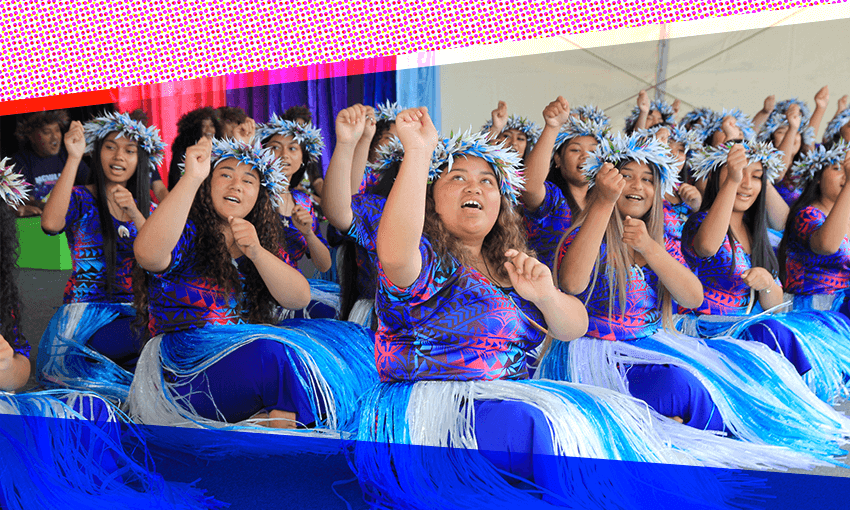Soulful Tokelauan singing, tasty seafood fritters and an urgent plea for sunscreen stations as Sela Jane Hopgood wraps up day two at Polyfest.
Read day one’s highlights here
The largest Polynesian traditional dance competition in the world, ASB Polyfest, saw many different cultures come together to learn from and about one another. On day two, the diversity stage carried on celebrating cultural knowledge and links to family through music, dance, costume and cultural speeches.
While cultures from Turkey, South Korea and Philippines showcased their traditions on stage, the Cook Islands stage began its speech competition, and Sāmoa and Tonga proceeded with day two of theirs.
Here is a recap of Thursday and what to expect today:
The diversity stage brings the energy
As I was heading to the diversity stage for the first performance at 9am, one school caught my attention, with the students wearing matching t-shirts and blue floral headpieces which in the Tokelau language are called pa.
This was McAuley High School’s first ever Tokelauan group and they made themselves known by getting the crowd to chant the greeting “Malo ni” (hello). The soulful harmonies as the students sang their national anthem, followed by songs that reflected their gratitude for being present and showcasing Tokelau on stage, rang out. An acknowledgement to their ancestors and the importance of holding on to one’s culture was refreshing, especially as many schools on the diversity stage use a music backing track for their performance.
St Cuthbert’s Chinese and Vietnamese groups were a great example of skilful dancing using props that create a spectacular viewing experience. The Chinese group used traditional fans, which the student leaders said were delicate “and advised students that if they drop their fan, they’ll have to do some burpees”. The Vietnamese group wore mint-coloured tunics, the traditional attire for women, and bamboo hats, which they had painted together as a group.
Coming third place last year on the diversity stage, Avondale College’s Indian group brought in one of the largest crowds yesterday, with its energetic performance, which featured multiple costume changes and an upbeat soundtrack that transported you to a dance scene from a Bollywood film. The student leaders shared that their costumes, which included palazzo pants, are traditionally worn in celebrations and festivals,.
Highlight of the day: Finding a food stall that sells chop suey on rice – it’s next to the mini doughnuts, in the group of stalls heading towards the entrance to the Tongan stage.
Also, seeing Niuean musician Malcolm Lakatani giving a tutorial on how to play the Niuean palau or nafa (drum), which is carved out of the trunk of the selie tree, to primary school students who in exchange shared their favourite “why did the chicken cross the road?” jokes. Absolutely wholesome.
Lowlight of the day: Just as how there are information tents scattered around the Manukau Sports Bowl, I would love to see sunscreen stations near the main stages for attendees to slip, slop, slap on the go. We’re grateful to have the sun join us again this year, but if you’re planning to attend for the whole day, I encourage you to take sunscreen with you.
Food recommendation: Sister Sei is a new small business, two weeks old in fact, led by Sāmoan and Croatian entrepreneur Tee Mau’u, who is a passionate chef. This is Mau’u’s first time serving at Polyfest, with seafood fritters, raw energy slaw, pina colada chia pudding and a Sāmoan pineapple beverage called vaifala on offer.
Mau’u wants to cook food that reflects her Sāmoan heritage and is good for you, fuelling you with energy, especially during a long, entertainment-packed day at Polyfest. She prides herself on making food that people with allergies can enjoy.
I highly recommend Sister Sei’s “chowdown fritter”, a play on the word chowder – a mussel-based fritter that is gluten and egg-free and drizzled with curried mayo. Find Sister Sei’s food stall near the Diversity Stage.
General vibe: Day two at Polyfest was much like day one, which is largely to do with the fact that the only schools in attendance are those performing and that the main four stages have yet to open.
I’ve performed at Polyfest in the past on a Friday and have attended as a spectator on a Saturday, and I have to admit I have enjoyed walking around the venue with smaller crowds these past two days. I expect a larger turnout today, with families perched on the grass in front of the Cook Islands, Sāmoa and Tonga stages, holding umbrellas up for shade and waving their island fans to catch a hint of breeze on a hot day.
What’s on today?
Diversity stage enters its final day of performances, but it’s the beginning of the Cook Islands stage, with division two and three schools such as James Cook High School, Aorere College, Onehunga High School and Tamaki College performing first.
The Niue stage opens up today with a speech competition, the Sāmoan stage kicks off with the co-ed schools section and the Tongan stage also begins with performances such as the ma’ulu’ulu, lakalaka and the crowd-pleaser mako, which is a fast-paced warrior dance where young men sit, roll and lie down in quick succession to the upbeat rhythm of a drum.
Schools worth watching today include De La Salle College’s Taufakaniua on the Tongan stage at around 1.50pm, and Ōtāhuhu College’s lakalaka around 3.20pm. This will showcase the true essence of Tongan culture, especially as the lakalaka is the national dance of the Kingdom. Manurewa High School won on the Sāmoan stage last year for the first time and they’ll be looking to secure that spot again at around 3.45pm, while Avondale College’s Sāmoan group will be tough competition, having placed top three for many years. They’re guaranteed to wow the crowd at around 1.10pm.
This is Public Interest Journalism funded through NZ On Air.



